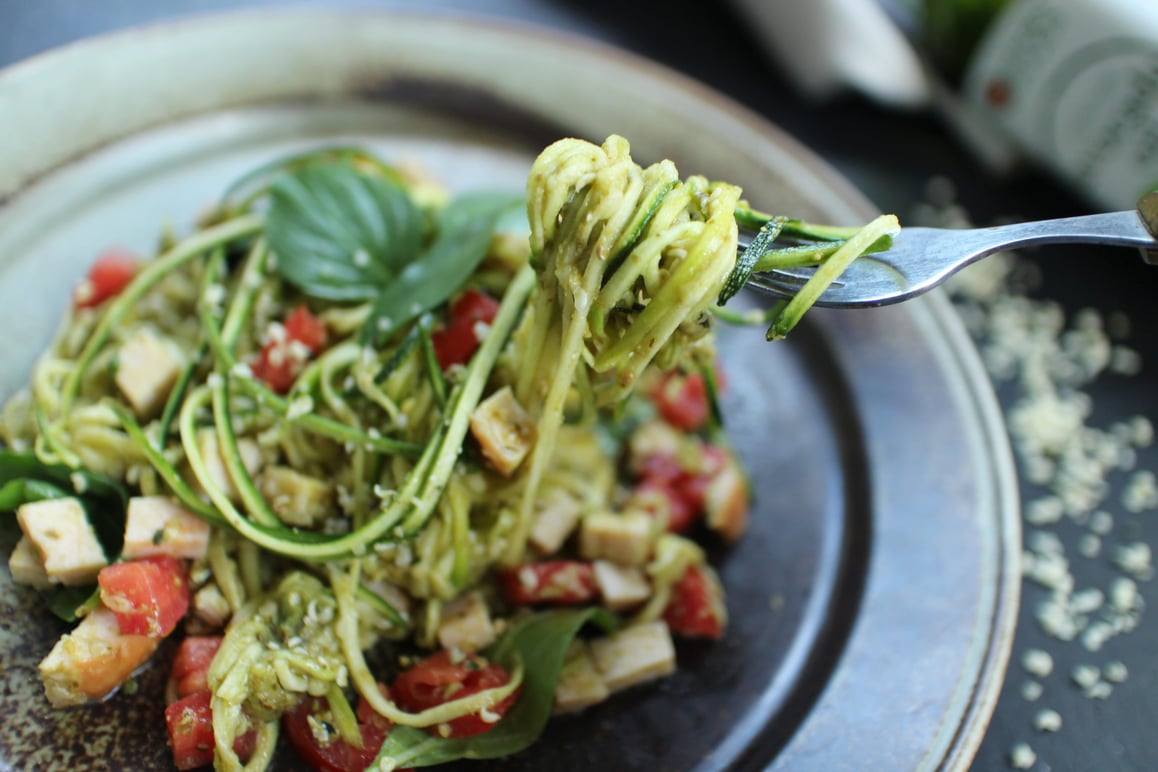Creating Keto Food Products with LabelCalc Keto. The Ketogenic Diet. Ketones. Ketosis. We can all agree that Keto might just be the biggest fad to hit the food & beverage industry in the last few years, if not ever. This high fat, low-carb lifestyle has us forgetting what skim milk is and instead diving head-first into our formerly off-limits favorites like bacon, full-fat cheeses and butters of all types, and without the guilt to boot. Americans everywhere are rejoicing at the simplicity of lowering their carb counts and embracing delicious alternatives while experiencing effortless weight-loss benefits. And as members of the food industry, we're eating it up too. If you haven't surfed the Keto-wave just yet, but are curious about creating Keto food products to appeal to this growing audience, never fear, we're here to teach you how easy it is to coast on this ever-evolving trend.
 Zucchini noodles make a quick and easy grain alternative when you want to create keto food products that are "pasta" based.[/caption] Cauliflower has also become a leading ingredient in low-carb cooking due to it’s versatility, neutral flavor and scant carbohydrate value. It can be “riced” and used for rice-based dishes such as risottos and stir-fry or cauliflower can be “mashed” and create a delicious alternative for loaded mashed potatoes.
Zucchini noodles make a quick and easy grain alternative when you want to create keto food products that are "pasta" based.[/caption] Cauliflower has also become a leading ingredient in low-carb cooking due to it’s versatility, neutral flavor and scant carbohydrate value. It can be “riced” and used for rice-based dishes such as risottos and stir-fry or cauliflower can be “mashed” and create a delicious alternative for loaded mashed potatoes.
Net Carbs
Creating Keto food products does not have to be a complicated process. Actually, the most important rule to creating keto products successfully is knowing how carbohydrates and fiber work together to create “net carbs” and then simply create your product recipes around this particular value. Let’s start at the beginning. Net carbs are simply the carbohydrate value in a serving less the dietary fiber. For example, if a serving of rice contained 25g of carbohydrates and 5 grams of dietary fiber, the net carbohydrate value for that serving of rice would be 20g. 25g carbohydrates – 5 grams of dietary fiber = 20g net carbs Keto followers have a daily allotment of carbs that typically ranges between 20-50g net carbs per day. Keeping carbohydrate intake this drastically low is the key to unlocking the quick weight-loss benefits that most keto-followers are looking to achieve by maintaining a state of ketosis. Without diving too deep into the science, when the body is in a state of ketosis, it is forced to switch it’s preferred fuel source from carbohydrate to fat. This is why this diet requires a high intake of fat in conjunction with maintaining a low intake of carbohydrate as the body will be looking to fat sources for energy. Given the flavor profile of high-fat foods, creating keto recipes can be a very delicious process as long as you remember to keep the net carbohydrate value low per serving. (We recommend under 10g net carbs per serving).Getting Creative
When creating Keto food products, it’s important to remember that you have 2 other macro-nutrients you can work with in order to compensate for the reduction in carbohydrates. And if you want to use carbohydrates in your recipe, they need to have a high-fiber value to offset the total carbohydrate count. You can reduce carbohydrates in a dish by implementing these tips:Swap Grains for Low-Carb Alternatives
For example: If you want to create a pasta-based prepared Keto meal, you can easily reduce the carbohydrate value by replacing starchy pasta with spaghetti squash or zucchini noodles while still maintaining a decadent flavor by taking full advantage of heavier ingredients that naturally accompany a pasta dish such as oils, cheese and high-fat meats. Sauteing zucchini noodles in garlic-infused olive oil is a great way to lock flavor into your new noodle alternative that will compliment the other components of the meal. [caption id="attachment_6062" align="aligncenter" width="1158"] Zucchini noodles make a quick and easy grain alternative when you want to create keto food products that are "pasta" based.[/caption] Cauliflower has also become a leading ingredient in low-carb cooking due to it’s versatility, neutral flavor and scant carbohydrate value. It can be “riced” and used for rice-based dishes such as risottos and stir-fry or cauliflower can be “mashed” and create a delicious alternative for loaded mashed potatoes.
Zucchini noodles make a quick and easy grain alternative when you want to create keto food products that are "pasta" based.[/caption] Cauliflower has also become a leading ingredient in low-carb cooking due to it’s versatility, neutral flavor and scant carbohydrate value. It can be “riced” and used for rice-based dishes such as risottos and stir-fry or cauliflower can be “mashed” and create a delicious alternative for loaded mashed potatoes.



